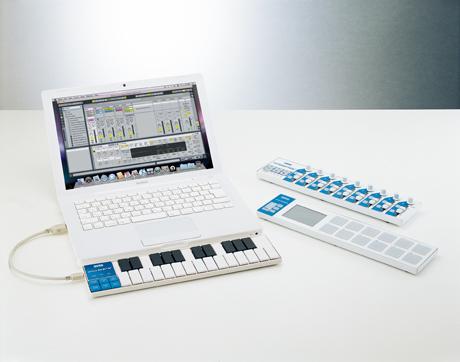Korg nanoSeries: tiny MIDI controllers are big news for mobile musos
Korg announce the nanoSeries, a range of three slim-line USB-powered MIDI controllers: nanoKEY, nanoPAD and nanoKONTROL.
Korg aren't "bigging up" their new nanoSeries USB-powered MIDI controllers - quite the opposite, in fact, as they're some of the most compact controllers we've ever seen. They seem to be designed with the laptop musician in mind, which is sweet music to our ears; as we've noted before, by the time you've factored in an audio interface, MIDI controller and whatever else you need to make music on the move, it all starts to look a lot less luggable. Anyway, check 'em out:

To date, super-mobile controllers have been thin on the ground (the Novation Nocturn and Kenton Killamix Mini are notable exceptions), so we reckon Korg could be on to a winner with these pocket-friendly peripherals, assuming that they prove to be more than mere gimmickry in practice, of course. Here's a quick rundown…
nanoKEY

This 25-key, velocity-sensitive MIDI keyboard is our current hot favourite, as there really isn't anything else like it available. Buttons for Octave Up/Down are provided, as are ones for Pitch Up/Down and Mod. We're not sure how the latter will work exactly - perhaps they are pressure-sensitive. There's also a CC Mode which, when enabled, means that the keys send MIDI CCs instead of notes.
nanoPAD

Korg imply that the nanoPAD's 12 pads are derived from those of their popular padKONTROL unit, which picked up an impressive 9/10 rating back in CM100. This little feller even has a new feature of its own: a Chord Trigger function for firing off chords from a single pad. The pads can also transmit MIDI CCs, which Korg suggest will be great for soloing/muting tracks, triggering clips, etc.
There's also an X/Y pad with Roll and Flam modes, to facilitate "ultra-realistic drum grooves", and it can transmit MIDI CCs too. Finally, you can configure up to four scenes' worth of settings, so you "actually have access to 48 notes/chords and, 60 MIDI controllers". Like the nanoKEY, it has three velocity curves and a fixed velocity mode.
Want all the hottest music and gear news, reviews, deals, features and more, direct to your inbox? Sign up here.
nanoKONTROL

Rounding out the trio, this one crams in nine faders, nine knobs, 18 switches and a transport section. Usefully, the switches have attack/decay times, which, as Korg explain, "allows you to smoothly feed controller messages into parameters such as wet/dry levels for an effect". It also has four configurable scenes. Our only concern is that the faders might be too short to be useful, but we'll reserve judgment until we actually get our hands on one.
We predict that the niche-filling nanoSeries will be a big hit, and you can expect to pay £49 for the nanoKEY and £59 each for the nanoKONTROL and nanoPAD when they hit the shelves in Q3 2008. You can expect to read the CM review around the same time, but until then,
has further details.